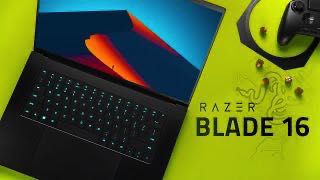9 min to read
Lenovo Legion 9i vs Razer Blade 16 - The Easy Choice!
Original video published on Nov 18, 2023

Among premium gaming laptops, the Razer Blade 16 and Lenovo Legion 9i are two of the top 16-inch choices available. Both of these laptops are powerhouses, equipped with the impressive RTX 4090, and are ideal for those seeking a desktop replacement in a more portable form. While their high price tags reflect their top-tier status, they cater to a specific audience that values power and portability over cost. Let’s delve into the specifics of each to see how they stack up against each other.

Price and Specifications
| Razer Blade 16 | Lenovo Legion 9i | |
|---|---|---|
| CPU | INTEL i9-13950HX | INTEL i9-13980HX |
| GPU | NVIDIA RTX 4090 (175W) | NVIDIA RTX 4090 (175W) |
| RAM | 32GB DDR5 | 32GB DDR5 |
| STORAGE | 2 x 1TB NVME SSD | 2 x 1TB NVME SSD |
| DISPLAY | 16” DUAL (UHD 120HZ + FHD 240HZ) MINI-LED | 16” (3200 x 2000) MINI-LED 165 HZ |
| COST | $4299 USD | $3733 USD |
The Razer Blade 16, priced at $4,300, is fully loaded with a 32 GB RAM, an Intel i9 13950HX CPU, and a unique dual display capable of switching between different resolutions and refresh rates. The Lenovo Legion 9i, slightly more budget-friendly at $3,700, also features an RTX 4090, but with a slightly more powerful i9 13980HX CPU.
Design and Build

The design philosophies of these two laptops differ significantly. The Razer Blade 16 maintains a traditional notebook appearance, characterized by a horizontal layout and a classic black, aluminum chassis. This design gives it a premium feel, consistent with Razer’s established aesthetic. In contrast, the Lenovo Legion 9i features a deeper build with a unique pattern on the lid, presenting a sleek yet refined look without being excessively flashy.
Ports Placement and Selection
| Razer Blade 16 | Lenovo Legion 9i | |
|---|---|---|
| USB-A | 3 x USB-A 3.2 Gen 2 | 2 x USB-A 3.2 Gen 1 |
| USB-C | 1 x USB-C 3.2 Gen 2 | 1 x USB-C 3.2 Gen 1 |
| Thunderbolt | 1 x Thunderbolt 4 | 2 x Thunderbolt 4 |
| HDMI 2.1 | ✅ | ✅ |
| SD Card Reader | ✅ | ✅ |
| Ethernet (RJ45) | 🚫 | ✅ |
An interesting point of differentiation is the placement of ports. Lenovo opts for rear port placement on the Legion 9i, a practical design choice for cable management, especially for those using external peripherals. The Blade 16, on the other hand, places its ports on the side. Both laptops offer a similar number of ports, but the Legion 9i includes an additional RJ45 port and more Thunderbolt ports compared to the Blade 16.
Charging Solutions
One notable feature of the Lenovo Legion 9i is the inclusion of a secondary, lighter 140W charger in addition to the main 330W GaN charger. This is particularly convenient for users who are constantly on the move, offering a lighter alternative to the heavier main charger. The Razer Blade 16’s charger, while smaller than the Legion 9i’s main charger, does not come with a secondary option.

Compare Razer Blade 16 and Lenovo Legion 9i charger

Compare Lenovo Legion main and secondary charger
Display Quality

| Razer Blade 16 | Lenovo Legion 9i | |
|---|---|---|
| SRGB | 100% | 100% |
| ADOBE RGB | 93% | 90% |
| P3 | 100% | 97% |
| NITS | 674 | 708 |
| DELTA AVG | 0.73 | 0.97 |
Both laptops boast stunning mini LED displays, but each with its unique advantages. The Razer Blade 16 offers a dual native resolution feature, allowing users to switch between 3840 x 2400 @ 120 Hz and 1920 x 1200 @ 240 Hz. This flexibility caters to various needs: higher resolution for content creation and lower resolution for an enhanced gaming experience. The Lenovo Legion 9i, although not offering dual resolution, has a notably brighter display, making it ideal for HDR content consumption.
Camera and Security Features
Both laptops are equipped with 1080p cameras. The Razer Blade 16 includes Windows Hello facial recognition, while the Lenovo Legion 9i offers a fingerprint scanner integrated into the power button for secure login. The webcam quality of both laptops is similar, providing adequate video under regular room lighting conditions.

Webcam quality of Razer Blade 16 and Lenovo Legion 9i
Keyboard and Touchpad
 The Lenovo Legion 9i features a unique water cooling system, which results in a slightly altered keyboard placement. Its keys feel clicky and comfortable for typing, and it includes a full-size numeric keypad. However, this design slightly reduces wrist-rest space. The Razer Blade 16’s keyboard, while aesthetically pleasing with its RGB lighting, feels a bit too flat for gaming. In contrast, its touchpad is larger and more responsive, although it has a shallower clicking distance.
The Lenovo Legion 9i features a unique water cooling system, which results in a slightly altered keyboard placement. Its keys feel clicky and comfortable for typing, and it includes a full-size numeric keypad. However, this design slightly reduces wrist-rest space. The Razer Blade 16’s keyboard, while aesthetically pleasing with its RGB lighting, feels a bit too flat for gaming. In contrast, its touchpad is larger and more responsive, although it has a shallower clicking distance.
Both the Razer Blade 16 and Lenovo Legion 9i feature quick-switch functionality for performance profiles, with shortcuts ‘Fn + P’ on the Blade 16 (when plugged in) and ‘Fn + Q’ on the Legion 9i.
 Lenovo’s inclusion of replaceable WASD keycaps adds a customizable aspect to the Legion 9i, a small but appreciated touch.
Lenovo’s inclusion of replaceable WASD keycaps adds a customizable aspect to the Legion 9i, a small but appreciated touch.
Fingerprint
In terms of fingerprint, the Razer Blade 16’s anti-fingerprint coating does reduce marks, but it’s not immune; regular cleaning is required to maintain its pristine appearance. The Legion 9i, while sporting a fingerprint-resistant top cover, tends to accumulate fingerprints on its keyboard deck, is similar to the Dell XPS 15 which has a rubberized texture.
Speakers
However, the Lenovo Legion 9i seems to have cut corners with its audio system, featuring only two 2-watt speakers compared to the Razer Blade 16’s superior four upward-firing speakers.
Performance Comparison



Both laptops are equipped with the powerful RTX 4090 GPU, capable of reaching 175 Watts, but they differ in their CPU choices. The Legion 9i sports a slightly more powerful i9 13980 HX compared to the i9 13950 HX in the Razer Blade 16. In practical terms, this translates to slightly better performance in applications like Adobe After Effects and Premier Pro, as well as in coding environments on the Legion 9i. However, the difference is not so significant as to be a deal-breaker.





When it comes to gaming, the Razer Blade 16 takes a slight lead, especially at its native QHD resolution. This could be attributed to Razer’s focus on GPU performance over CPU. Despite these differences, both laptops handle gaming effortlessly, even at high resolutions.



Fan Noise and Heat Management
Under full load, the Legion 9i’s fans are a bit quieter than the Blade 16’s. Both laptops manage heat effectively, maintaining similar temperatures under heavy use. Surprisingly, despite its water cooling system, the Legion 9i runs a few degrees hotter than the Blade 16, which could contribute to its slightly better performance due to higher sustained CPU speeds.


Upgradity

Accessing the internals of both laptops is straightforward. Both offer swappable drives, RAM (up to 64 GB), and Wi-Fi 6E cards. The Legion 9i’s internal layout is more complex, featuring a unique cooling setup and slightly larger battery, but accessing the RAM requires extra effort.
Battery Life
| Razer Blade 16 | Lenovo Legion 9i | |
|---|---|---|
| BATTERY LIFE | 1 HOUR 36 MINS | 2 HOURS 4 MINS |
Despite their large batteries, both laptops have relatively poor battery life, a common issue with high-performance gaming laptops.
Final Verdict

Considering the price difference, with the Razer Blade 16 costing $600 more than the Legion 9i, the choice seems clear. The Legion 9i offers similar, if not better, performance and features at a significantly lower price point. While the Razer Blade 16 has its merits, such as superior speakers, the price disparity makes it hard to justify as the better option.
In conclusion, for those in the market for a high-end gaming laptop, the Lenovo Legion 9i presents itself as the more rational choice, offering a balanced mix of performance, features, and value.
We hope this comprehensive comparison has been helpful. If you have any further questions or thoughts, feel free to share them in the comments section. Don’t forget to like this post if you found it informative, thank you!




Comments